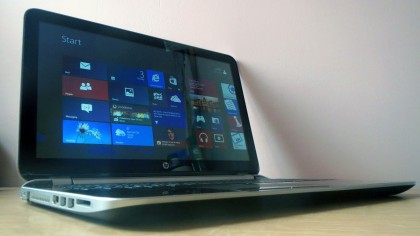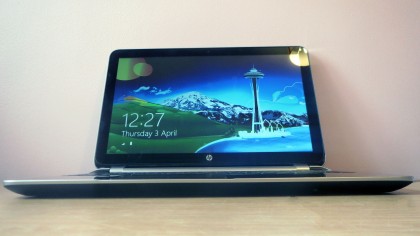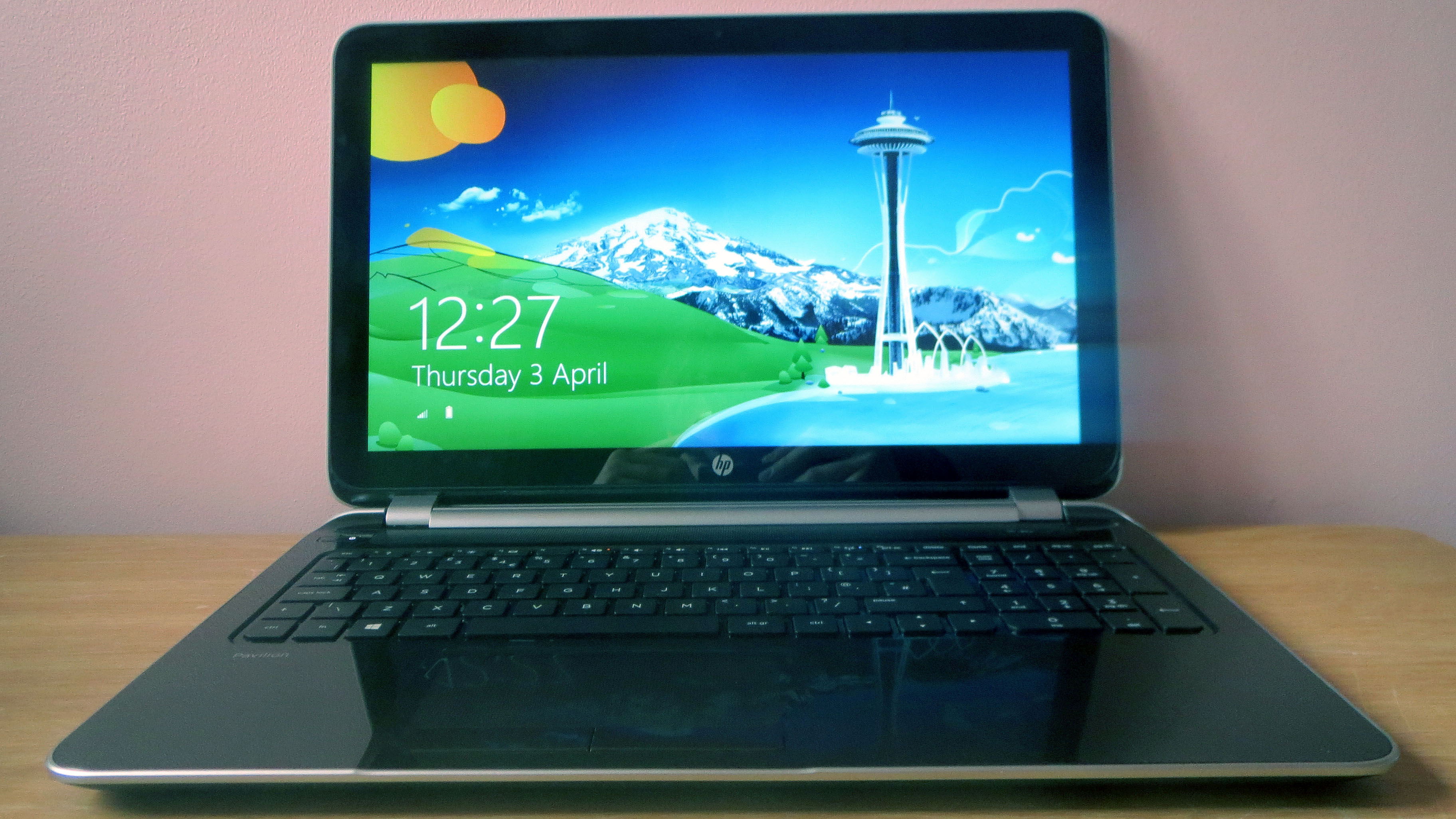Why you can trust TechRadar
3DMark:
Ice Storm: 22,198
Cloud Gate: 1,938
Fire Strike: 328
Cinebench 11.5:
CPU: 1.13
GPU: Wouldn't run
PCMark 8:
Home score high performance: 1,496
Home score power saver, no GPU: 1,329
Home battery test, high performance: 3hr 22mins
Home battery test, power saver: 4hr 35mins
Dirt 3:
Ultra Low, 1,366 x 768: 34fps/45fps
Low, 1,366 x 768: 27fps/35fps
Medium, 1,366 x 768: 21fps/24fps
Hard disk:
AS SSD sequential read: 107MB/s
AS SSD sequential write: 94MB/s
The HP's modest AMD chip didn't blow away our benchmarks. The HP's Cinebench CPU score of 1.13 lags behind every other system we've mentioned here. It's not an awful result, as we still had no issues using the HP for general tasks (web browsing, word processing and running Windows 8's Start screen apps ran without complaint.
The HP scored 22,198 in 3D Mark's Ice Storm, which is the easiest test of this benchmark suite. Again, that's slower than every other notebook here, and in some cases significantly worse: the Toshiba M50, with its Core i5 CPU and discrete graphics card, was almost three times as quick.
The HP only caught up in the Fire Strike benchmark, which is the toughest of all three 3D Mark tests. The HP scored 328, which is poor – but it's better than the other HP system, and the Lenovo laptop.
Sign up to the TechRadar Pro newsletter to get all the top news, opinion, features and guidance your business needs to succeed!
In real-world terms it means that it's only worth buying this laptop if your gaming ambitions are suitably modest. We loaded DiRT 3, which is extremely scalable, and could still only manage to get a 35fps playable average at 1,366 x 768 and low quality – and this result was hampered by a poorer minimum framerate of 27fps. We only got a completely smooth gameplay experience at DiRT's Ultra Low settings. The Toshiba, meanwhile, ran the game at High settings at 54fps.
When running in High Performance mode and in PC Mark 8's Home battery test, the HP lasted for 3hrs 22mins – worse than the Toshiba M50, and better than the Toshiba C50. This unremarkable result was stretched out by just over an hour by turning on Power Saver mode and dimming the screen.
The HP isn't exactly quick, but it performed better in a few other departments. The hard disk's sequential read and write speeds of 107MB/s and 94MB/s are better than the drive in the more expensive Toshiba M50, and we had no problems with heat or noise – the modest specification means this is a cool, quiet laptop.
HP has included a touchscreen on this system, which is a boon – not all budget machines include touch-friendly panels. Elsewhere, though, there's less to like about this screen.

For starters, we're no fans of 15.6in panels with 1,366 x 768 resolutions: it makes the screen look pixelated and there's not enough room to comfortably have two windows side-by-side. It's no good for 1080p movies, either.
The HP's screen is short on quality as well as pixels. The brightness level of 188 nits is low for a laptop, and it's paired with a high black level of 0.61 nits. That makes for a contrast ratio of just 305:1, and that means several big issues: deep blacks look more like dull greys, the high-end lacks punch, and colours throughout feel insipid.
That lifeless feeling isn't helped by the 6,894K colour temperature, which is far too cool for our liking, and the average Delta E of 10.51 is poor. That means the colours aren't rendered accurately, with deeper blue and purple shades in particular suffering. This screen might be OK for casual games and browsing the web, but it's just not got the quality for any sort of work.
The HP isn't exactly cut out for media, either. Its speakers have good volume, but they're dominated by the tinny high-end. Songs, in particular, are drowned by their hi-hats. The mid-range is weak by comparison, and there's just no bass.
HP's latest Pavilion makes a good impression thanks to its attractive design, 15.6in touchscreen and low price but, get hands-on with this machine, and it's clear where the budget has bitten. The modest AMD chip only has enough power for basic computing, and the screen and speakers don't have the quality for anything more than light gaming or media. The keyboard, too, just isn't good enough for serious work.
We liked
This is one of the best-looking budget laptops we've seen. The lid is coated with silver plastic and it's got a stylish dotted pattern, and the colours are reversed on the inside: the wrist-rest is black with lighter dots.
The great design is helped elsewhere by the smart metal-effect border and the clean curves throughout, and it's not too thick and heavy, especially considering the 15.6in screen. You won't be weighed down if you carry the HP day-to-day.
AMD's A4-series APU has enough power to handle both general computing tasks and casual gameplay, and the rest of the specification covers the budget bases, and includes a DVD writer.

We disliked
HP's keyboard looks like a smart Scrabble-tile unit, but it's disappointing to use thanks to a lack of travel and an inconsistent, cheap-feeling typing action.
The screen, too, let us down: it's got a low resolution, poor colour accuracy, and a lack of brightness and contrast leaves images and web pages looking insipid and pale.
The speakers have a prominent high-end that dominates the rest of the range to the point where we just wouldn't want to use them for music and gaming. The rest of the specification isn't great either: the AMD chip doesn't have the grunt for work, and 4GB of RAM is the bare minimum these days, even for budget notebooks.
Final verdict
HP's latest machine looks good, feels sturdy, and is easy to carry day-to-day, and its AMD APU makes it a well-rounded budget system. The poor screen, speakers and keyboard, though, mean it's tricky to recommend this system for any sort of more intensive use – it's only suitable for basic tasks. If you need a modest laptop and you're concerned about its looks more than the fine details, though, you'll be happy with this.
Mike has worked as a technology journalist for more than a decade and has written for most of the UK’s big technology titles alongside numerous global outlets. He loves PCs, laptops and any new hardware, and covers everything from the latest business trends to high-end gaming gear.
